
Test-Bank-for-Heizer-Operations-Management-9e
.pdf94.Briefly discuss what is meant by critical path analysis. What are critical path activities and why are they important?
The critical path consists of those tasks that determine the overall project completion time (or that will delay the completion of the project if they are delayed); these must be managed most closely to ensure timely completion of the project. Critical path analysis is the determination of which task elements are on, or likely to be on, the critical path (the longest path through the network). (Determining the project schedule, moderate)
95.What are the earliest activity start time and latest activity start time, and how are they computed?
The earliest start time is the earliest time at which an activity may start and still satisfy all precedence requirements. The latest start time is the latest time at which an activity may start and still satisfy both precedence requirements and the overall project completion time. (Determining the project schedule, moderate)
96.How is the expected completion time of a project activity, and of a PERT project, computed?
The expected completion time of a project activity uses the Beta distribution; expected time is the weighted average of optimistic, most likely, and pessimistic time estimates. Expected completion of a PERT project is the sum of the expected times for individual activities that are on the critical path. (Determining the project schedule, moderate)
97.Describe in words how to calculate a project’s standard deviation. What assumption allows that calculation to be accurate?
Add the variances of the activities on the critical path and then take the square root. We can do this because we assume that the activities are independent. (Variability in activity times, difficult)
98.Briefly describe the concept of cost/time trade-off and how it is used.
Cost/time trade-off is fundamentally PERT with additional information provided that enables one to monitor and control project cost and to study possible cost/time trade-offs. This can be done by making a budget for the entire project using the activity cost estimates and by monitoring the budget as the project takes place. Using this approach, we can determine the extent to which a project is incurring a cost overrun or a cost underrun. In addition, we can use the same technique to determine the extent to which a project is ahead of schedule or behind schedule. (Cost-time trade-offs and project crashing, moderate)
51

99.What are the advantages of using PERT and CPM?
The advantages include its usefulness for scheduling and controlling large projects, its straightforward concept, its graphical displays of relationships between activities, its critical path and slack time analysis, its ability to document processes, its wide range of applicability, and its usefulness in monitoring schedules and costs. (A critique of PERT and CPM, moderate)
PROBLEMS
100.Consider the network pictured below.
a.Enumerate all paths through this network.
b.Calculate the critical path for the network.
c.What is the minimum duration of the project?
d.How much slack exists at each activity?
(a) Possible paths are P-S (length 22), P-R-T (length 28), and Q-T (length 21). (b) The longest of these, P-R-T, is the critical path, at 28 time units. (c) There is no slack at P, R, or T since these are critical tasks. S has 6 units slack, since the path it is on totals only 22 units, compared to the critical path length of 28. Q has 7 units of slack since it is on a 21 length path, 7 less than the maximum. (Project management techniques: PERT and CPM, moderate) {AACSB: Analytic Skills}
52
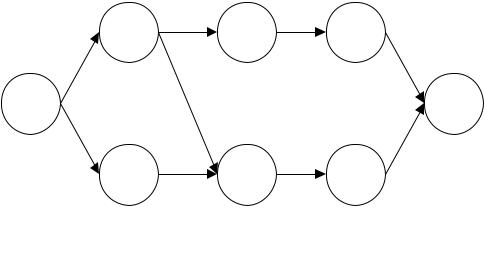
101. A network consists of the activities in the following list. Times are given in weeks.
Activity |
Preceding |
Time |
A |
-- |
8 |
B |
-- |
3 |
C |
A |
7 |
D |
A, B |
3 |
E |
C |
4 |
F |
D |
6 |
a.Draw the network diagram.
b.Calculate the ES, EF, LS, LF, and Slack for each activity.
c.What is project completion time?
(a)
(b,c)
Results
|
Early |
Early |
Late |
Late |
Slack |
Task |
Start |
Finish |
Start |
Finish |
|
A |
0 |
8 |
0 |
8 |
0 |
B |
0 |
3 |
7 |
10 |
7 |
C |
8 |
15 |
8 |
15 |
0 |
D |
8 |
11 |
10 |
13 |
2 |
E |
15 |
19 |
15 |
19 |
0 |
F |
11 |
17 |
13 |
19 |
2 |
|
Project |
19 |
|
|
|
(Project management techniques: PERT and CPM, moderate) {AACSB: Analytic Skills}
53
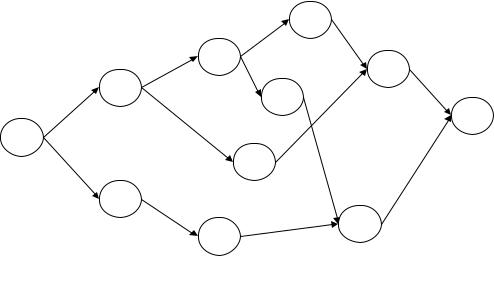
102.The network below represents a project being analyzed by Critical Path Methods. Activity durations are A=5, B=2, C=12, D=3, E=5, F=1, G=7, H=2, I=10, and J=6.
a.What task must be on the critical path, regardless of activity durations?
b.What is the duration of path A-B-E-H-J?
c.What is the critical path of this network?
d.What is the length of the critical path?
e.What is slack time at activity H?
f.What is the Late Finish of activity H?
g.If activity C were delayed by two time units, what would happen to the project duration?
(a) J; (b) 20; (c) A-B-G-I-J; (d) 30; (e) 5; (f) 24; (g) no impact.
Results
|
Early |
Early |
Late |
Late |
|
Task |
Start |
Finish |
Start |
Finish |
Slack |
A |
0 |
5 |
0 |
5 |
0 |
B |
5 |
7 |
5 |
7 |
0 |
C |
5 |
17 |
10 |
22 |
5 |
D |
0 |
3 |
10 |
13 |
10 |
E |
7 |
12 |
17 |
22 |
10 |
F |
3 |
4 |
13 |
14 |
10 |
G |
7 |
14 |
7 |
14 |
0 |
H |
17 |
19 |
22 |
24 |
5 |
I |
14 |
24 |
14 |
24 |
0 |
J |
24 |
30 |
24 |
30 |
0 |
|
Project |
30 |
|
|
|
(Project management techniques: PERT and CPM, moderate) {AACSB: Analytic Skills}
54
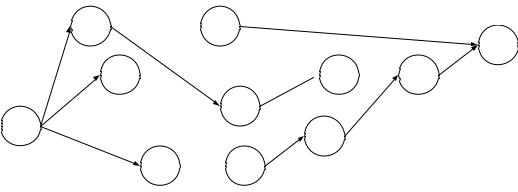
103. A network consists of the following list. Times are given in weeks.
Activity |
Preceding |
Duration |
A |
-- |
9 |
B |
A |
2 |
C |
A |
12 |
D |
A |
5 |
E |
B |
6 |
F |
B |
8 |
G |
C, F |
3 |
H |
D |
2 |
I |
H |
8 |
J |
G, I |
6 |
K |
E, J |
2 |
a.Draw the network diagram.
b.Which activities form the critical path?
c.How much slack exists at activities A and F?
d.What is the duration of the critical path?
(a) Network diagram
B  E
E
K
C  G
G  J
J
F
A
I
D  H
H
(b) paths A-D-H-I-J-K and A-C-G-J-K are critical; (c) A has no slack; F has 2 units (d) 32
(Project management techniques: PERT and CPM, moderate) {AACSB: Analytic Skills}
55
104. A partially solved PERT problem is detailed in the table below. Times are given in weeks.
Activity |
Preceding |
Optimistic |
Probable |
Pessimistic |
Expected |
Variance |
|
|
Time |
Time |
Time |
Time |
|
A |
-- |
7 |
9 |
14 |
|
1.361 |
B |
A |
2 |
2 |
8 |
|
0 |
C |
A |
8 |
12 |
16 |
|
0 |
D |
A |
3 |
5 |
10 |
|
1.361 |
E |
B |
4 |
6 |
8 |
|
0 |
F |
B |
6 |
8 |
10 |
|
0 |
G |
C, F |
2 |
3 |
4 |
|
0 |
H |
D |
2 |
2 |
8 |
|
1.000 |
I |
H |
6 |
8 |
16 |
|
2.778 |
J |
G, I |
4 |
6 |
14 |
|
2.778 |
K |
E, J |
2 |
2 |
5 |
|
0.250 |
a.Calculate the expected time for each activity. Enter these values in the appropriate column in the table above.
b.Which activities form the critical path?
c.What is the estimated time of the critical path?
d.What are the project variance and the project standard deviation?
e.What is the probability of completion of the project after week 40?
(a)A=9.5 B=3 C=12 D=5.5 E=6 F=8 G=3 H=3 I=9 J=7 K=2.5
(b)A-D-H-I-J-K; (c) 36.5; (d) 9.53, 3.09; (e) 0.13.
(Project management techniques: PERT and CPM, moderate) {AACSB: Analytic Skills}
56
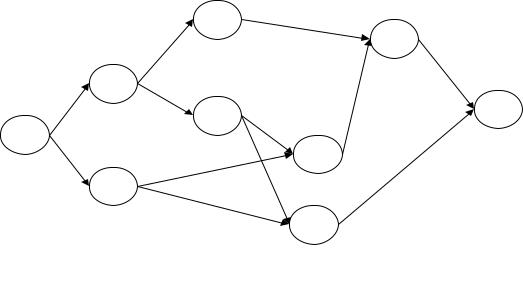
105. Consider the network described in the table below.
Activity |
Immediate |
Pessimistic |
Probable |
Optimistic |
|
Predecessor(s) |
|
|
|
J |
-- |
15 |
10 |
8 |
K |
-- |
9 |
8 |
7 |
L |
J |
10 |
6 |
5 |
M |
J |
3 |
3 |
3 |
N |
K,M |
9 |
5 |
1 |
O |
K,M |
10 |
7 |
4 |
P |
L,N |
10 |
8 |
3 |
a.Calculate the expected duration of each activity.
b.Calculate the expected duration and variance of the critical path.
c.Calculate the probability that the project will be completed in fewer than 30 time units.
(a) See table below. (b) Tasks J-M-N-P are critical. The sum of their expected durations is 26.00; the sum of their variances is 4.50. (c) The standard deviation along the path is = 2.12; the probability that Duration < 30 is the probability that z < (30 - 26.00)/2.12 = 1.89. The associated normal curve area is 0.97062.
|
Early |
Early |
Late |
Late |
Slack |
Mean |
Variance |
Task |
Start |
Finish |
Start |
Finish |
|||
J |
0 |
10.5 |
0 |
10.5 |
0 |
10.5 |
1.361111 |
K |
0 |
8 |
5.5 |
13.5 |
5.5 |
8 |
|
L |
10.5 |
17 |
19.5 |
26 |
9 |
6.5 |
|
M |
10.5 |
13.5 |
10.5 |
13.5 |
0 |
3 |
0 |
N |
13.5 |
18.5 |
13.5 |
18.5 |
0 |
5 |
1.777778 |
O |
13.5 |
20.5 |
19 |
26 |
5.5 |
7 |
|
P |
18.5 |
26 |
18.5 |
26 |
0 |
7.5 |
1.361111 |
|
Project |
26 |
|
|
|
Project |
4.5 |
|
|
|
|
|
|
Std.dev |
2.12132 |
(Project management techniques: PERT and CPM, mod.) {AACSB: Analytic Skills}
57
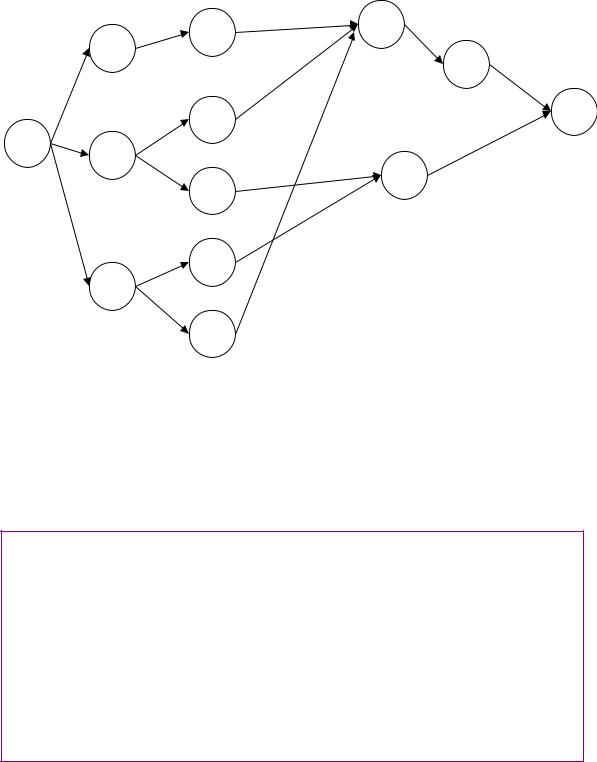
106.The network below represents a project being analyzed by Critical Path Methods. Activity durations are indicated on the network.
a.Identify the activities on the critical path.
b.What is the duration of the critical path?
c.Calculate the amount of slack time at activity H.
d.If activity I were delayed by ten time units, what would be the impact on the project duration?
(a)Critical activities are A-C-J-K; (b) The critical path is 26 time units; (c) Slack at H is 9 units; (d) I has 11 units slack--a ten unit delay would have no impact on the project.
Task |
Early Start |
Early Finish |
Late Start |
Late Finish |
Slack |
A |
0 |
5 |
0 |
5 |
0 |
B |
0 |
3 |
6 |
9 |
6 |
C |
5 |
16 |
5 |
16 |
0 |
D |
0 |
4 |
9 |
13 |
9 |
E |
3 |
10 |
9 |
16 |
6 |
F |
4 |
10 |
15 |
21 |
11 |
G |
3 |
7 |
17 |
21 |
14 |
H |
4 |
7 |
13 |
16 |
9 |
I |
10 |
15 |
21 |
26 |
11 |
J |
16 |
22 |
16 |
22 |
0 |
K |
22 |
26 |
22 |
26 |
0 |
|
Project |
26 |
|
|
|
(Project management techniques: PERT and CPM, mod.) {AACSB: Analytic Skills}
58

107.Three activities are candidates for crashing on a CPM network. Activity details are in the table below.
Activity |
Normal Time |
Normal Cost |
Crash Duration |
Crash Cost |
X |
8 days |
$6,000 |
6 days |
$8,000 |
Y |
3 days |
$1,800 |
2 days |
$2,400 |
Z |
12 days |
$5,000 |
9 days |
$7,700 |
a.What is the crash cost per unit time for each of the three activities?
b.Which activity should be crashed first to cut one day from the project's duration; how much is added to project cost?
c.Which activity should be the next activity crashed to cut a second day from the project's duration; how much is added to project cost?
(a) crash cost X = $1,000 per day; crash cost Y = $600 per day ; crash cost Z = $900 per day
(b) select Y, adding $600; (c) select Z, adding $900
(Cost-time trade-offs and project crashing, moderate) {AACSB: Analytic Skills}
108.Three activities are candidates for crashing on a CPM network. Activity details are in the table below.
Activity |
Normal Time |
Normal Cost |
Crash Duration |
Crash Cost |
A |
9 days |
$8,000 |
7 days |
$12,000 |
B |
5 days |
$2,000 |
3 days |
$10,000 |
C |
12 days |
$9,000 |
11 days |
$12,000 |
a.What is the crash cost per unit time for activity A?
b.What is the crash cost per unit time for activity B?
c.Which activity should be crashed first to cut one day from the project's duration; how much is added to project cost?
d.Which activity should be the next activity crashed to cut a second day from the project's duration; how much is added to project cost?
e.Assuming no other paths become critical, how much can this project be shortened at what total added cost?
(a) $2,000; (b) $4,000; (c) A, $2,000; (d) A again, $2,000 additional; (e) 5 days, $15,000.
(Cost-time trade-offs and project crashing, moderate) {AACSB: Analytic Skills}
59

109. A network consists of the following list. Times are given in weeks.
Activity |
Preceding |
Optimistic |
Probable |
Pessimistic |
A |
-- |
5 |
11 |
14 |
B |
- |
3 |
3 |
9 |
C |
-- |
6 |
10 |
14 |
D |
A, B |
3 |
5 |
7 |
E |
B |
4 |
6 |
11 |
F |
C |
6 |
8 |
13 |
G |
D, E |
2 |
4 |
6 |
H |
F |
3 |
3 |
9 |
a.Draw the network diagram.
b.Calculate the expected duration and variance of each activity.
c.Calculate the expected duration and variance of the critical path.
d.Calculate the probability that the project will be completed in less than 28 weeks.
(a)
(b,c) |
Expected |
|
|
|
|
|
Variance |
Std. dev. |
Slack |
Variance |
|
Task |
time |
||||
A |
10.5 |
2.25 |
1.5 |
3 |
|
B |
4 |
1 |
1 |
8 |
|
C |
10 |
1.778 |
1.333 |
0 |
1.778 |
D |
5 |
0.444 |
0.667 |
3 |
|
E |
6.5 |
1.361 |
1.167 |
8 |
|
F |
8.5 |
1.361 |
1.167 |
0 |
1.361 |
G |
4 |
0.444 |
0.667 |
3 |
|
H |
4 |
1 |
1 |
0 |
1 |
Project |
22.5 |
|
|
Project |
4.139 |
|
|
|
|
Std. dev. |
2.034 |
(d) z = (28-22.5)/2.03 = 2.71, (P<=28) = .997
(Project management techniques: PERT and CPM, moderate) {AACSB: Analytic Skills}
60
